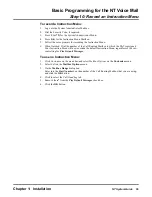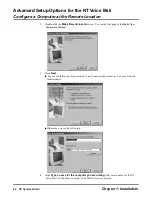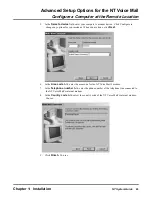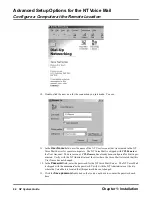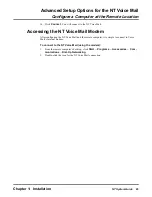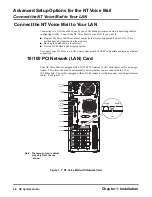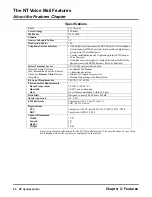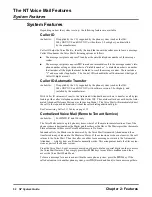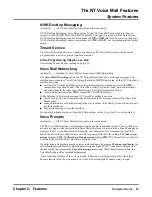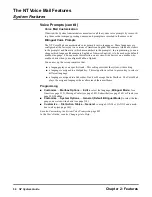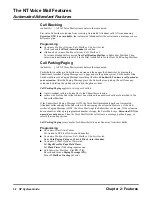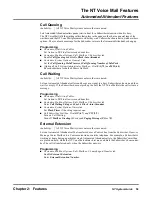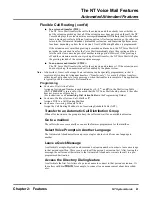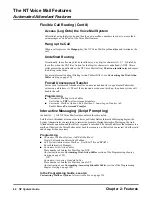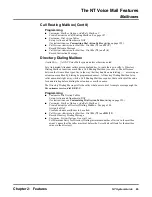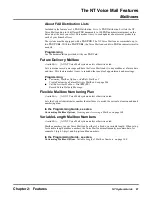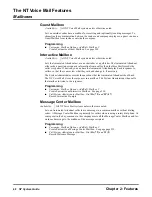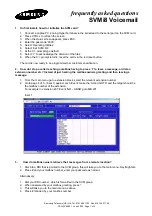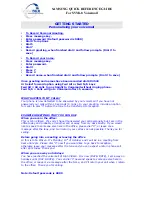
The NT Voice Mail Features
System Features
Chapter 2: Features
NT System Guide
53
To set up Centralized Voice Mail:
Phone Programming for the Master ONYX IV
Q
All systems must be equipped with either
T1
or Analog Tie Lines.
Q
Make sure that the extension numbers in the Master and in the Slaves do not overlap.
Q
Connect the Voice Mail to the Master
ONYX IV
in the usual way. Do all the normal Voice Mail
programming to this system.
Q
Connect a Tie Line (or Tie Line Group) between the Master and each Slave. Do all the normal
Tie Line programming. Be sure to assign each Tie Line to a Trunk Group Access Code.
Q
All Tie Lines for voice mail access must be grouped in a single terminal rotary with a common
first trunk (
EA
program).
Q
Two-digit access codes, such as 90-99, must be assigned to the Tie Line Group.
Q
All Dial Action Tables for the Automated Attendant are supported, such as call by name, by
extension, and by group.
Q
A call ringing in to the Master system (local trunk) can be redirected to any system, without the
caller being aware of the transfer.
Phone Programming for Each Slave ONYX IV
Q
Make sure that the extension numbers in the Master and in the Slaves do not overlap.
Q
QP,
Mailbox Installed: Enter
Y.
Q
QP, VM
Master Station: Enter the extension number of the 1st Tie Line in the Tie Line Group
that terminates to the Master
ONYX IV
.
Q
QP, IMMEDIATE MSG-LAMP OFF:
Enter
Y
if you want the
MSG
lamp to go out as soon as
the user presses the
MSG
key to access their mailbox. Otherwise, there will be a slight delay (as
the Voice Mail updates the lamp information) and the
MSG
lamp may still be on after the user
listen to messages.
If you wish, you can terminate a trunk to the
VM
Master Station Number, so that a trunk that nor-
mally rings a Slave
ONYX IV
can be answered by the Voice Mail. However, this scenario uses both
outgoing and incoming Tie Lines — from the Slave to the Master and then back again. You may not
want to have the Tie Lines occupied like this during the day, but you may want to terminate a trunk
to the
VM
Master only for Night Mode calls.
If the table does not contain a match for the Caller ID,
the Automated Attendant will look at your AST assignment(s).
Voice Mail Programming
Q
If several tenants share an ONYX IV phone system: In System Options, Tenant, enable
Intertenant Messaging , and enter the number of remote tenants in the Number of Tenants box.
(Also decide which tenant number will be assigned to each
ONYX IV
phone system.) See
page 314.
Q
Enable Remote Tenant on the General tab of the Tenant Options dialog box. See page 338.
Enter the access digits in the Access Digits box the enter the Trunk Group Access code for the
Tie Line that connects the tenant to the Master. See page 340.
Q
As much as possible when any phone system is installed in the Voice Mail, create Subscriber
Mailbox numbers that match the extension numbers in the phone system.
Voice Mail Programming for the 384i only
Q
For each Subscriber in Mailbox Options, set the Access Digit/Lamp String On String and
Access Digit/Lamp Off String on page 282.
Notes:
(1)
All the features in the User's Guide are available to the Master system. The following are not
available to the Slaves: Call Parking, Call Waiting, Call Queuing, Record a Conversation.
(2)
Unscreened transfers
(UTRFs)
should not be used unless extension users are forwarding their
calls to the
VM
Master number or the phone system is programmed to send (hunt) incomplete
transfers to the Voice Mail. Otherwise, a caller whose transfer is incomplete will return to the
Voice Mail, but the Voice Mail will not know where the call came from (because there is no
protocol), so the caller won't be able to press 1 to leave a message. If the called remote station
forwards the call back to the Voice Mail, one more Tie Line will be needed. ACD applications
are supported only in the Master system.
Summary of Contents for NVM-NT
Page 28: ...Table of Contents Chapter 5 Maintenance xxvi NT System Guide ...
Page 130: ...Installing SMDI 102 NT System Guide Chapter 3 Programming ...
Page 146: ...Customizing Caller I D Tables General Tab 118 NT System Guide Chapter 3 Programming ...
Page 156: ...Customizing Callout Options Optional Tab 128 NT System Guide Chapter 3 Programming ...
Page 182: ...Customizing Distribution Lists General Tab 154 NT System Guide Chapter 3 Programming ...
Page 338: ...Customizing Port Options General Tab 310 NT System Guide Chapter 3 Programming ...
Page 358: ...Customizing System Options Timers Tab 330 NT System Guide Chapter 3 Programming ...
Page 362: ...Customizing System Options Timers Tab 334 NT System Guide Chapter 3 Programming ...
Page 367: ...Customizing Tenant Options General Tab Chapter 3 Programming NT System Guide 339 ...
Page 396: ...Viewing and Printing Reports System Options Report 368 NT System Guide Chapter 3 Programming ...
Page 400: ...Performing a Local Backup Backup Dialog Box 372 NT System Guide Chapter 3 Programming ...
Page 440: ...Using Port Activities 412 NT System Guide Chapter 3 Programming ...
Page 454: ...Using Message Status Message Status Dialog Box 426 NT System Guide Chapter 3 Programming ...

